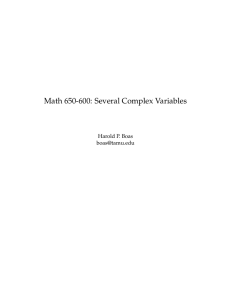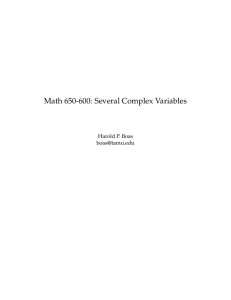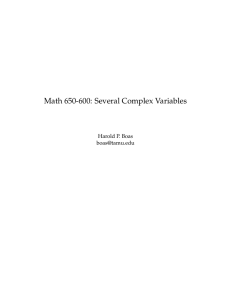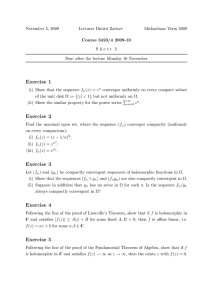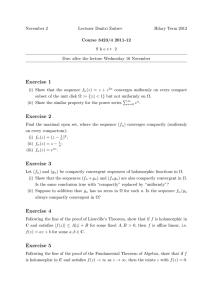Math 650-600: Several Complex Variables Harold P. Boas
advertisement
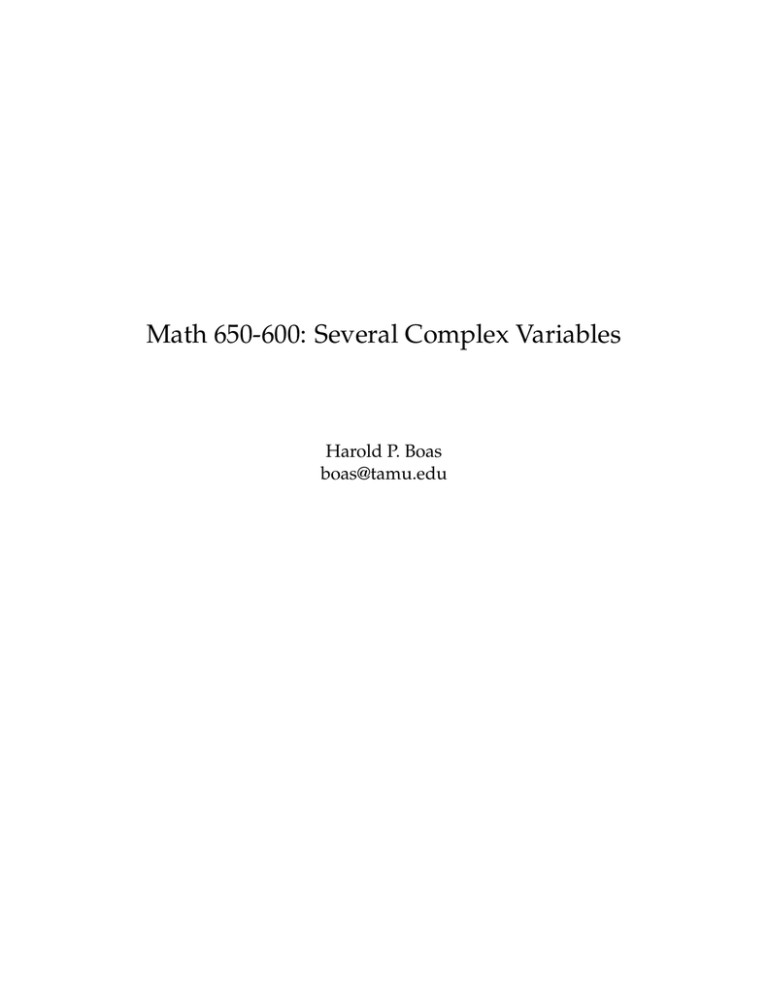
Math 650-600: Several Complex Variables
Harold P. Boas
boas@tamu.edu
Announcement
Math Club movie
The Dalı́ Dimension
3:00 PM, Wednesday, May 4
Blocker 156
Math 650-600
May 3, 2005 — slide #2
Solving ∂: the final step
We have solved the ∂-equation by proving the key estimate
∗
k f k ϕ2 ≤ k∂ f k ϕ1 + k∂ f k ϕ3
for smooth, compactly supported f on a pseudoconvex domain Ω. The C ∞ (Ω) functions ϕ1 ,
ϕ2 , and ϕ3 are given in terms of two auxiliary functions ϕ and ψ by ϕ 3 = ϕ, ϕ2 = ϕ − ψ, and
ϕ1 = ϕ − 2ψ. The function ϕ, constructed last time, is a C ∞ very strongly plurisubharmonic
exhaustion function for Ω.
∗
It remains to construct ψ to guarantee density: namely, if f is a (0, 1)-form in Dom ∂ ∩ Dom ∂,
∞
then there exists a sequence { f (j) }∞
j=1 with coefficients in C0 (Ω) such that
∗
∗
k f − f (j) k ϕ2 + k∂ f − ∂ f (j) k ϕ1 + k∂ f − ∂ f (j) k ϕ3 → 0
as j → ∞.
The strategy is to cut f off and mollify.
Math 650-600
May 3, 2005 — slide #3
Choice of ψ
We will use below the condition ϕ3 − ϕ2 = ψ = ϕ2 − ϕ1 .
Choose functions η j in C0∞ (Ω) such that 0 ≤ η j (z) ≤ 1 for all z and η j (z) = 1 when dist(z, bΩ) ≥
2
1/j. Define ψ ∈ C ∞ (Ω) via eψ = 1 + ∑∞
j=1 |∇η j | (locally finite sum).
Density, step 1. If f ∈ L2 (Ω, ϕ2 ), then η j f → f in L2 (Ω, ϕ2 ) by the dominated convergence
theorem for Lebesgue integrals. If f ∈ Dom ∂, then similarly η j ∂ f → ∂ f in L2 (Ω, ϕ3 ), and if
∗
∗
∗
f ∈ Dom ∂ , then η j ∂ f → ∂ f in L2 (Ω, ϕ1 ).
Density, step 2. By step 1, showing that ∂(η j f ) → ∂ f in L2 (Ω, ϕ3 ) is equivalent to showing that
R
k∂(η j f ) − η j ∂ f k ϕ3 → 0. The square of this norm is ≤ Ω |∂η j |2 | f |2 e−ϕ3 . By the choice of ψ, this
integral tends to 0 by dominated convergence since |∂η j |2 | f |2 e−ϕ3 ≤ eψ | f |2 e−ϕ3 = | f |2 e−ϕ2 ,
and f ∈ L2 (Ω, ϕ2 ).
Math 650-600
May 3, 2005 — slide #4
More on density
Density, step 3. For compactly supported f , convolve with mollifiers to get f e with coefficients
in C0∞ (Ω) such that f e → f and ∂ f e → ∂ f . Since ∂ is a differential operator with constant
coefficients, it commutes with convolution: ∂( f e ) = (∂ f )e .
∗
∂
−ϕ2 f ), we have |∂ ∗ (η f ) −
j
j
∂z j (e
∗
∗ 2 −ϕ
of ψ again). Then |∂ (η j f ) − η j ∂ f | e 1
∗
∂ f in L2 (Ω, ϕ1 ).
∗
Density, step 4. Since ∂ f = ∑nj=1 e ϕ1
η j ∂ f | ≤ e ϕ1 −ϕ2 |∂η j | | f |
≤ e(ϕ1 −ϕ2 )/2 | f | (by the choice
∗
nated convergence ∂ (η j f ) →
≤ | f |2 e−ϕ2 , so by domi-
∗
Density, step 5. Since e ψ ∂ differs from a constant-coefficient differential operator by a multipli∗
∗
cation operator M, we have for compactly supported f that (e ψ ∂ + M)( f e ) = ((eψ ∂ + M) f )e
∗
∗
∗
∗
∗
→ (eψ ∂ + M) f . Since M( f e ) → M f , it follows that e ψ ∂ ( f e ) → eψ ∂ f , and hence ∂ ( f e ) → ∂ f .
We are done.
Math 650-600
May 3, 2005 — slide #5
Summary
Our main result for the semester is the equivalence of the following properties of a domain Ω
in Cn .
• Ω is a domain of holomorphy.
• Ω is convex with respect to the plurisubharmonic functions.
• There is a holomorphic function on Ω for
which bΩ is the natural boundary.
• − log dist(z, bΩ) is plurisubharmonic.
• Ω is holomorphically convex.
b satis• ∀K ⊂⊂ Ω, the holomorphic hull K
b
fies dist(K, bΩ) = dist(K, bΩ).
• ∀ sequence in Ω with no accumulation
point in Ω,
∃ a holomorphic function on Ω that is unbounded on the sequence.
Math 650-600
• Ω admits a continuous plurisubharmonic exhaustion function.
• Ω admits a C ∞ strongly plurisubharmonic exhaustion function.
• Ω satisfies the continuity principle for
families of analytic discs.
May 3, 2005 — slide #6
Additional equivalences
• In case Ω has class C 2 boundary, the Levi form is non-negative on complex tangent vectors.
• Solvability of the ∂-equation on forms of arbitrary degree: When 1 ≤ q ≤ n, for every
∂-closed (0, q)-form f with coefficients in C ∞ (Ω), there exists a (0, q − 1)-form u with
coefficients in C ∞ (Ω) such that ∂u = f .
We proved only that pseudoconvexity implies solvability of the ∂-equation on (0, 1)-forms,
which is all we needed to solve the Levi problem.
Math 650-600
May 3, 2005 — slide #7
